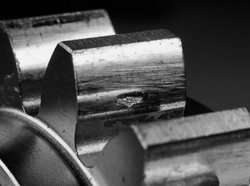Influences of Lubricant and Lubrication Condition and their Extended Consideration in the Calculation of the Pitting Load Carrying Capacity of Gears
Research Topic
| Short Title | Lubrication Influence on the Pitting Load Carrying Capacity II |
| Start of Project | Q3/2022 |
| Funding | FVA-Nr. 459/IV, IGF-Nr. 22363 N/1 Federal Ministry for Economic Affairs and Climate Action, BMWK |
| Contact | Dr.-Ing. T. Tobie |
Project Description

The determination of the pitting load carrying capacity is a basic verification in gear design. The lubricant or lubrication condition, the tooth flank roughness and the gear material, among other things, have a decisive influence on the formation of pititting. Costs of raw materials and demand for better power-to-weight ratios are increasingly necessitating the use of modern lubricants and manufacturing technologies in order to increase the pitting load carrying capacity. In the research projects FVA 459/III [Kön19], FVA 521/I [Kol10] and FVA 521/II [Kön17], positive influences of synthetic lubricants and superfinishing processes on the pitting load carrying capacity were demonstrated. However, these increases in the pitting load carrying capacity cannot be adequately represented by the current standard calculation methods such as according to ISO 6336 [ISO19] or DIN 3990 [DIN87], since the underlying factors depend only on nominal values and disregard essential parameters.
The aim of this research project is to develop a scientifically validated approach to the relationship between the relevant lubricant properties, the lubrication condition in operation and the resulting pitting load carrying capacity. Extensive experimental investigations, which are compared with theoretical models, are to be used to develop a standardized calculation approach for taking account of the lubrication condition in the calculation of the pitting load carrying capacity.
The targeted, more differentiated calculation method is of great interest to small and medium-sized enterprises in particular. Due to limited test capacities, it is difficult for them to carry out their own experimental investigations on the scale applied for. They benefit from the more comprehensive view and applicability of the existing knowledge. A gear design with a calculation approach that can take into account load carrying capacity-increasing effects due to synthetic lubricants or optimized manufacturing processes helps them to manufacture more economically and efficiently.
Literature
[DIN87] DIN 3990:1987: Tragfähigkeitsberechnung von Stirnrädern (1987).
[ISO19] ISO 6336:2019: Calculation of load capacity of spur and helical gears (2019).
[Kol10] Koller, P.; Tobie, T.; Höhn, B.-R.: IGF-Nr. 14908, FVA-Nr. 521/I - Heft 957 - Optimierung Flankentragfähigkeit - Steigerung der Zahnflankentragfähigkeit durch Kombination von Strahlbehandlung und Finishingprozess. Forschungsvereinigung Antriebstechnik e.V., Frankfurt/Main (2010).
[Kön17] König, J.; Tobie, T.; Stahl, K.: IGF-Nr. 17145, FVA-Nr. 521/II - Heft 1245 - Optimierung Flankentragfähigkeit II - Tragfähigkeit gestrahlter und gleitgeschliffener Zahnflanken unter besonderer Berücksichtigung des Randzonen- und des Schmierfilmzustands. Forschungsvereinigung Antriebstechnik e.V., Frankfurt/Main (2017).
[Kön19] König, J.; Tobie, T.; Stahl, K.: IGF-Nr. 18652, FVA-Nr. 459/III - Heft 1337 - Schmierstoffeinfluss Grübchentragfähigkeit - Schmierstoffeinflüsse auf die Grübchentragfähigkeit bei unterschiedlichen Flankenzuständen. Forschungsvereinigung Antriebstechnik e.V., Frankfurt/Main (2019).
[Sie19] Siewerin, B. J.; Dobler, A.; Tobie, T.; Stahl, K.: Applicability of an Oil Based Calculation Approarch for Wear Risk and Wear Lifetime to Grease Lubricated Gear Pairings. Proceedings of the ASME 2019 (2019).